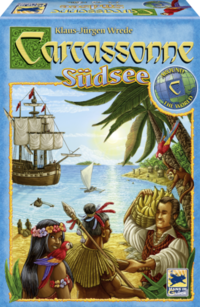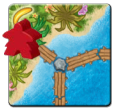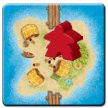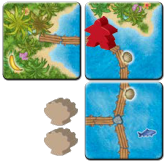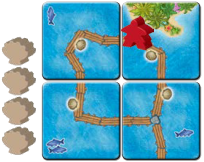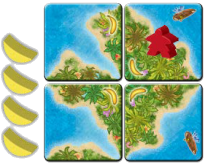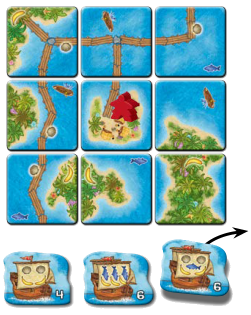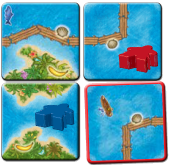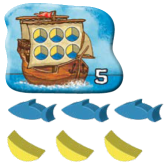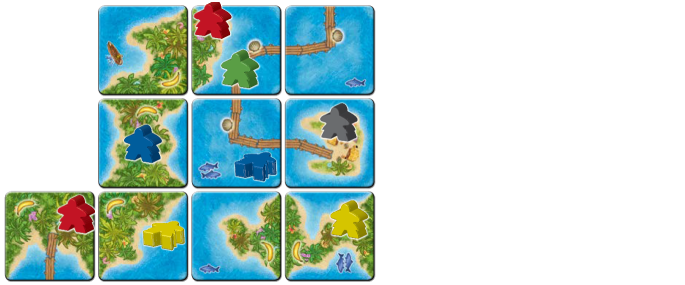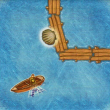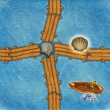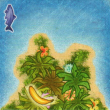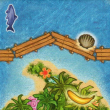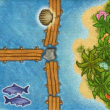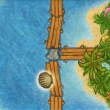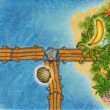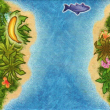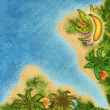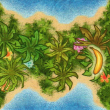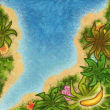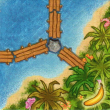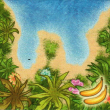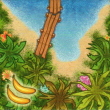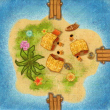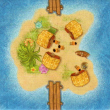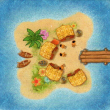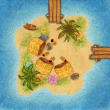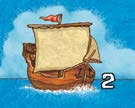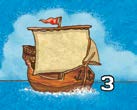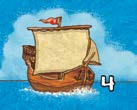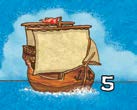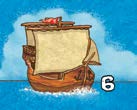Difference between revisions of "South Seas Base Game/ro"
(Created page with "* '''Cartonașul de pornire''' este plasat în mijlocul mesei. Cartonașele rămase sunt amestecate și plasate în mai multe stive astfel încât fiecare jucător poate trage cu ușurință cartonașe. * '''Jetoanele cu corăbii''' sunt amestecate separat și formează o rezervă cu fața în jos. Trage și dezvăluie 4 jetoane cu corăbii li plasează-le cu fața în sus pe masă la îndemâna tuturor jucătorilor. * Fiecare jucător primește '''4 insulari''' în culo...") Tags: Mobile edit Mobile web edit |
(Created page with "== Desfășurarea jocului ==") Tags: Mobile edit Mobile web edit |
||
| Line 46: | Line 46: | ||
* 4. Jucătorul are acum '''posibilitatea''' de a '''livra''' mărfuri către 1 dintre '''corăbiile cu fața în sus''' și să încaseze punctele corespunzătoare. | * 4. Jucătorul are acum '''posibilitatea''' de a '''livra''' mărfuri către 1 dintre '''corăbiile cu fața în sus''' și să încaseze punctele corespunzătoare. | ||
Apoi, jucătorul următor își efectuează tura. | |||
<div lang="en" dir="ltr" class="mw-content-ltr"> | <div lang="en" dir="ltr" class="mw-content-ltr"> | ||
Revision as of 02:30, 17 May 2024
Mările Sudului – Ape albastre limpezi curg fără efort în jurul unor insule aparent nenumărate cu toate conectate de o rețea sofisticată de pontoane. Aici este locul unde oamenii ocupații care populează acest paradis ceresc zburdă împrejur pentru a culege darurile oferite lor de către natură. Pești din mare, banane de pe insule, iar pontoanele sunt aglomerate cu culegători de scoici care se dau mari cu ultima lor descoperire. Din când în când, vor acosta nave comerciale la insulă în căutare de încărcătură: insularul care aprovizionează comercianții cu mărfurile pe care le caută aceștia este bine răsplătit pentru deranjul său.
Informații generale și comentarii
Lansat original de Hans im Glück în 2013, Carcassonne: Mările Sudului este un joc isteț de plasare a cartonașelor pentru 2 până la 5 jucători, cu vârste de 8 în sus.
Componentele jocului
- 73 de cartonașe de mare (incluzând 1 cartonaș de pornire cu un verso mai înflorit): Acestea prezintă pontoane cu scoici, insule cu banane și mări cu pești.
- 24 jetoane cu corăbii: Acestea indică ce mărfuri trebuie livrate pentru a încasa punctele indicate.
- 1 carte de reguli
- 60 de jetoane de marfă din lemn (10 mici și 10 mici de fiecare tip): Fiecare jeton mic de marfă valorează cât 1 marfă de acel tip. Fiecare jeton mare de marfă valorează cât 3 mărfuri de acel tip.
- 19 jetoane cu bărci pescărești
- 20 de insulari de lemn (câte 4 în 5 culori): Fiecare insular poate servi drept culegător de banane, căutător de scoici, pescar sau negustor.
Prezentarea generală a jocului
Jucătorii efectuează ture plasând cartonașe de mare pe masă. Aceste cartonașe creează pontoane, insule, bazine maritime și piețe pe care jucătorii își pot plasa insularii pentru a strânge diferite mărfuri. La sfârșitul fiecărei ture, jucătorul activ poate alege să livreze mărfuri unei corăbii pentru a încasa puncte. Odată ce au fost plasate toate cartonașele de mare sau toate corăbiile au fost aprovizionate cu mărfuri, jocul se termină și jucătorul cu cele mai multe puncte este încoronat Rege al Mărilor Sudului.
Configurarea jocului
- Cartonașul de pornire este plasat în mijlocul mesei. Cartonașele rămase sunt amestecate și plasate în mai multe stive astfel încât fiecare jucător poate trage cu ușurință cartonașe.
- Jetoanele cu corăbii sunt amestecate separat și formează o rezervă cu fața în jos. Trage și dezvăluie 4 jetoane cu corăbii li plasează-le cu fața în sus pe masă la îndemâna tuturor jucătorilor.
- Fiecare jucător primește 4 insulari în culoarea aleasă de ei și îi plasează în fața lor ca rezervă.
- Cel mai tânăr jucător începe jocul.
Desfășurarea jocului
Jocul continuă în sensul acelor de ceasornic de la jucătorul de start. Fiecare jucător își efectuează tura în secvența următoare:
- 1. Jucătorul trebuie să tragă 1 cartonaș de mare și să îl plaseze în concordanță cu regulile de plasare a cartonașelor de mare.
- 2a. Jucătorul are posibilitatea de a plasa 1 insular din rezerva sa pe un cartonaș pe care tocmai ce l-a plasat SAU
- 2b. Jucătorul are posibilitatea de a recupera 1 insular de pe un cartonaș de mare și să îl plaseze înapoi în rezerva sa. (Un jucător are de asemenea posibilitatea de a alege să nu plaseze sau recupereze un insular.)
- 3. Dacă cartonașul plasat face ca 1 sau mai multe pontoane, insule, bazine maritime sau piețe să fie finalizate SAU este adăugată o barcă pescărească unui bazin maritim, are loc o evaluare și sunt acordate mărfuri sau corăbii.
- 4. Jucătorul are acum posibilitatea de a livra mărfuri către 1 dintre corăbiile cu fața în sus și să încaseze punctele corespunzătoare.
Apoi, jucătorul următor își efectuează tura.
1. Draw and place a tile
The first action a player must take on their turn is to draw a Sea tile from a face-down stack and place it connected to previously placed tiles. The following placement rules must be observed:
- The new tile (bordered with red in the following examples) must connect one or more of its four sides to those of previously placed tiles. A placement that connects only by corners is not allowed.
- New tiles must always continue pre-existing Bridges, Islands and/or Sea Regions.
A player may freely show their opponents their newly drawn tile in order to discuss placement options. In the rare case that a newly drawn tile may not be legally placed, it is removed from the game and the active player will draw a new tile to continue their turn.
2a. Place an Islander
After a player has placed a Sea tile, they may place an Islander according to the following rules:
- Only 1 Islander may be placed.
- The Islander must come from the player’s supply.
- The Islander may only be placed on the newly placed tile.
- The player must choose on which part of the newly placed tile they wish to place an Islander. Either as a…
The player may not place an Islander on a Bridge, Island or Sea Region if it is connected to a Bridge, Island or Sea Region that already contains one or more Islanders (even if some or all of the pre-existing Islanders belong to the active player). For example:
Note: If a player does not have any Islanders available in their supply, they do not have the option of placing one. No need to worry: There are several ways of retrieving those Islanders. Read on.
2b. Retrieve an Islander
If a player places no islander during her turn, she may instead retrieve one of her Islanders from the board and return it to her supply. No Wares or Ships are awarded. Note: A player may choose to neither place nor retrieve an Islander.[1]
3. Completed bridges, islands, sea regions, and markets are evaluated
When evaluating a completed feature, a player receives no points. Instead, Wares are awarded. Each type of feature gives a player a different type of Ware, or a Ship in the case of a completed Market.
Upon completion of a Bridge, Island or Sea Region, the player whose Islander occupy the completed feature receives Wares. Each player receives 1 Shell, 1 Banana or 1 Fish for each corresponding symbol present in the completed feature.
A completed bridge gives shells
A Bridge is complete when it is terminated on both ends, either by a junction (identified by the presence of a junction stone), an Island or a Market, or if the bridge forms a closed loop. This can result in bridges being very small or very large.
A completed island gives bananas
An Island is complete when all of its borders are complete and there are no internals gaps. This can result in Islands being very small or very large.
A completed sea region gives fish
A single Sea Region can consist of numerous tiles. A Sea Region evaluation can be triggered in two different ways:
- When a Sea Region is completely enclosed (by Bridges and/or Islands). OR
- When a Sea tile featuring a Fishing Boat is placed in an occupied Sea Region.
Important! A Fishing boat can only trigger an evaluation when it is first placed, and never during a later turn.
After Fish are awarded due to the placement of a Fishing Boat, the player covers one group of Fish in the corresponding Sea Region. If any groups of two fish are available, one of them must be covered. If no groups of two fish are available, a single fish is covered instead. Fish that have been covered by boats are not available to be gained during future evaluations.
A completed market gives a Ship token
A Market is complete when it is surrounded by 8 Sea tiles.
The player whose Islander occupies the completed Market gains the Ship token with the highest value, without delivering any goods. This token is placed face-down in front of that player and will give them points at the end of the game.
If there is more than one Ship token with the highest value, from these, the player takes one of their choice. The face-up supply of Ship tokens is then replenished to 4.
If several Markets are completed simultaneously, each player will receive the Ship token(s) they are owed in clockwise order from the active player. Replenish the face-up supply of Ship tokens to 4 after each token is awarded.
Multiple Islanders on one completed bridge, island or sea region
Through clever placement of Sea tiles and Islanders, it is possible for several Islanders to occupy the same Bridge, Island or Sea Region.
Similarly, it is possible for multiple Banana Pickers to occupy the same Island, or for multiple Shell Collectors to occupy the same Bridge.
When a feature with multiple Islanders is completed, only the player with the most Islanders present receives the depicted Wares. In case of a tie, all tied players receive the Wares.
Returning Islanders to players' supplies
After a Bridge, Island, Sea Region or Market is completed and evaluated, all Islanders present at the completed feature are returned to their owner’s supply, so that they may be used on a following turn.
Note: Islanders in Sea Regions whose evaluation was triggered by the addition of a Fishing Boat are also returned (even though the Sea Region is not necessarily considered "complete").
It is possible for a player to place an Islander, complete a feature and have the Islander return to their supply in one turn. To do so, players must act in the following sequence:
- With the placement of a new Sea tile, complete an unoccupied Bridge, Island, Sea Region or Market.
- Place a Shell Collector, Banana Picker, Fisherman or Merchant (again, the feature must be unoccupied).
- The completed Bridge, Island, Sea Region or Market is evaluated and the player receives the appropriate reward.
- The Islander is returned to its owner’s supply.
4. Deliver to a Ship and gain points
At the end of a player’s turn, he may deliver Wares to exactly 1 Ship. A player may choose from the supply of 4 faceup Ships. The Wares a player must deliver are depicted on the sail of each Ship. To deliver to a Ship, the player returns the appropriate Wares to the supply, and places the Ship face-down in front of him. A new Ship is then drawn so that there are again 4 face-up Ships (unless the pile is empty). The number depicted at the bottom right of the Ship indicates the number of points it is worth at the end of the game.
Some Ships require particular combinations of Wares, while other Ships denote a flexible requirement:
Now, the player’s turn is over and the next player clockwise may begin their turn.
Game End and Winner
The game ends after the turn in which the last Sea tile is placed or the last Ship has been acquired.
Evaluation of incomplete features
All incomplete Bridges, Islands and Sea Regions are evaluated as though they had been completed. Players receive Shells, Bananas and Fish as they would have during the game.
Important: Incomplete Markets offer no reward.
- Left Island Red has 2 Banana Pickers on the Island where Blue only has 1. Red has more Banana Pickers than Blue. Red alone receives the 4 Bananas shown on the Island.
- Bridge Green is alone on the Bridge and receives 3 Shells.
- Market Black gets nothing for his incomplete Market.
- Sea Region Yellow and Blue each have 1 Fisherman present. They each receive 4 Fish.
- Right Island Yellow is alone and receives 2 Bananas.
End game scoring and winner
Now we total each player's points:
- Each player receives points for their acquired Ships.
- Each player receives 1 point for each 3 remaining Wares, regardless of type.
Whoever has the most points is crowned King of the South Seas and wins the game.
Clarifications
Referință pentru cartonașe
Note de subsol
Pentru licențierea și semnificația pictogramelor te rugăm să vizitezi Pagina pictogramelor.
- ↑
 The ZMG rules state if a player has zero Islanders in her supply, she may retrieve one of her Islanders from the board. This seems to be a mistranslation from the original German rules.
The ZMG rules state if a player has zero Islanders in her supply, she may retrieve one of her Islanders from the board. This seems to be a mistranslation from the original German rules.
